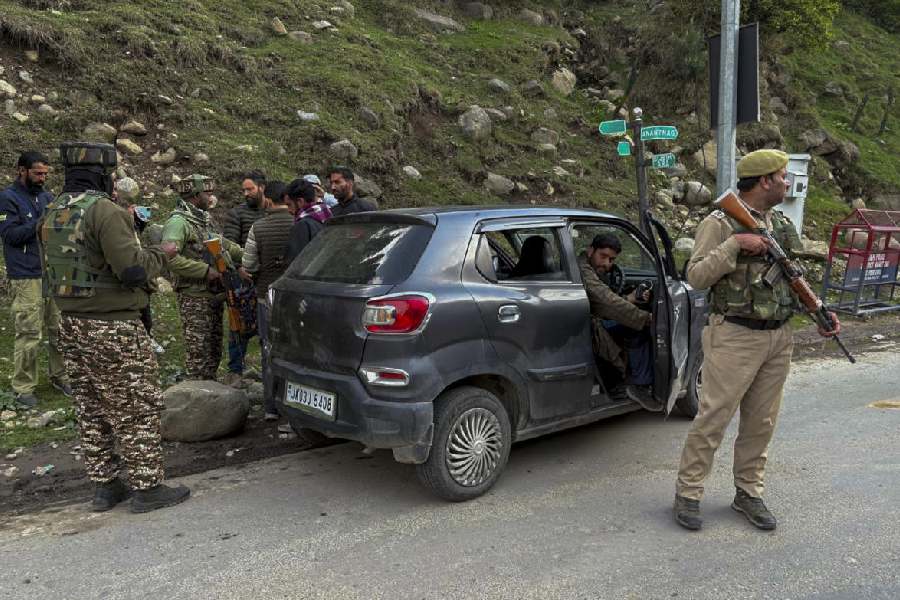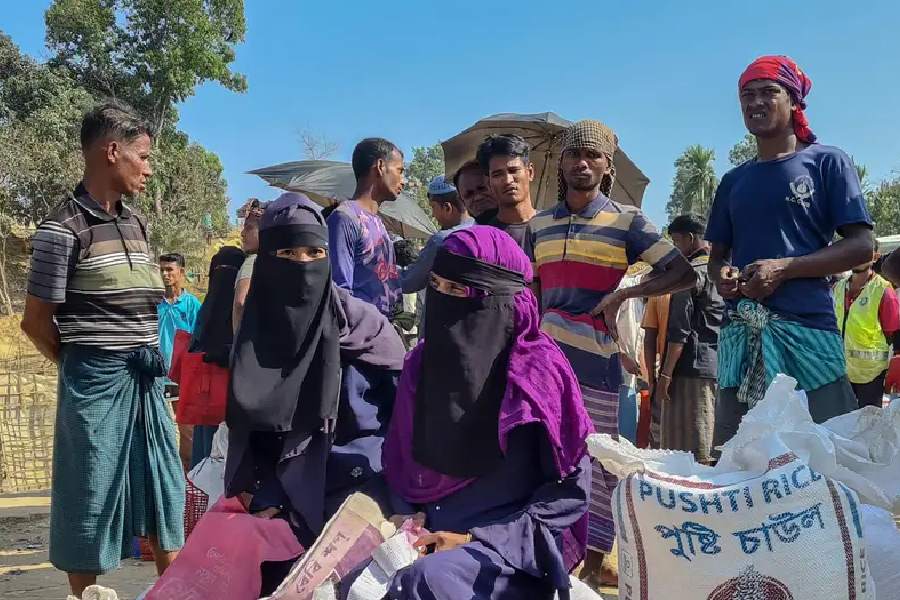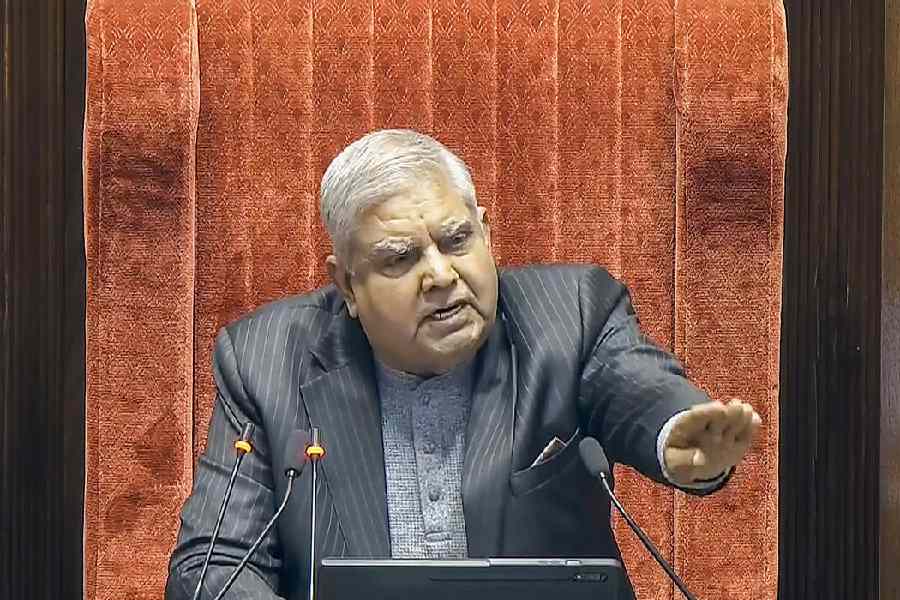 |
 |
Over the past month and a half, the city and the districts have been plastered with hoardings announcing the launch of Discovery Channel in Bengali.
The channel launched its six-hour Bengali feed in prime time from 6pm to midnight on April 15. The feed eventually became 24 hours from June 1. West Bengal, as it is, contributes seven per cent to Discovery Channel’s total viewership and is among its top five priority markets.
Bengali was added to Discovery’s language bouquet after Hindi, Tamil and Telugu. It has led to a great adventure.
“Amay ektu joriye dhoro toh (Kindly embrace me),” says a sturdy Caucasian man, just rescued from the high seas, approaching another man on the deck with arms wide open. But no romantic overtone is intended in the show on whale hunters. One wonders what the original request was.
“Tough bugger,” says a sailor about his boat in the same programme, in its English version. His Bengali avatar says: “Etar bhalo dom achhey.”
But if the channel can ignore the nuances of language — well, broad meanings too — most viewers aren’t complaining. Going local has paid rich dividends. “The average ratings of Discovery in West Bengal witnessed a rise of 20 per cent after the launch of the six-hour Bengali feed,” says Rahul Johri, senior vice-president and general manager-South Asia, Discovery Networks Asia-Pacific. Some glitches remain, but Discovery says it tries to take care of the Bengali. “The dubbed scripts and tapes go for multiple quality and technical checks with the highest-rated language consultants in India,” says Johri. The results are better than Nat Geo’s efforts with Bengali.
 |
National Geographic Channel, another multinational channel in the same non-fiction space, had chosen Bengali as the second language to go local with in India, after Telugu, in November 2010.
Says Keertan Adyanthaya, managing director, National Geographic Network, India: “We got a lot of feedback from viewers that they loved our shows, but because of the pace of narration, or the accent of the narrator, it was sometimes difficult to keep track of what was being said. Hence, putting in Bengali feed was the logical decision. It also makes us accessible to viewers who only prefer to watch Bengali channels.”
Playing the mother tongue card helped Nat Geo too. The channel saw its viewership share go up by approximately 50 per cent after launching the Bengali feed. No wonder market leader Discovery followed suit.
Hopefully, Discovery won’t repeat some of Nat Geo’s translations. We are not attuned to hearing lions being referred to as “boro beral (big cat)”. It is equally painful to listen to linguistic hotchpotch like “Eta amader kachhey emotionally koshtokor jokhon hatider songe singhader dwando hoy (It is emotionally difficult for us when elephants fight with lions)” or “Eta sothik orthey efficient killing (It is efficient killing in the true sense)”.
 |
Tukro khobor, onusandhan, bondhubandhab and adda.
Some key words on Facebook are English words written in Bengali and some are translated into Bengali. For example, the “account” is “account” written in Bengali, while “profile” is brittanto and “home” is mool pata. To “poke” a friend in Bengali is to give him a khoncha. To accept a friend request is to say nishchit to it. A “friend” is a bondhu, but “password” remains “password”.
 |
“The Translations Application was launched in 2008 and enables Facebook users all over the world to translate Facebook into different languages,” says a spokesperson. Facebook is currently available in seven Indian languages: Hindi, Punjabi, Tamil, Telugu, Bengali, Malyalam and Nepali. A Marathi Facebook is in the pipeline. It indicates a strong growth in the base of local-language users in India and Bangladesh.
But the Bengali Facebook has not left every user pleased. “I tried it for a few weeks, then I went back to English,” says 28-year-old Shibani Chakraborty.
“It feels a little weird. We are so used to the ideas in English, it doesn’t always work in Bengali,” Shibani adds. Agrees Saikat Bhattacharya, 24, a postgraduate student at IIT Chennai. “It would be a little funny if I have to check my dewal (wall),” he says with a laugh.
Khoncha notwithstanding, the Bengali Facebook with its bondhubandhab seems to be doing not too badly. Grameenphone, Bangladesh’s top telecom service provider, has partnered the translation of the site. Figures are not available for the number of people using the facility in Bengali, but Facebook says that more than 25 million are actively using the networking site in India.
 |
Now you can log on to Wikipedia for help on your Bengali assignments as well. Adda or jonaki, Rabindranath or nesha, you can find a range of subjects in the Bengali Wiki.
“The Bengali Wikipedia was launched in January 2004. At present Wikipedia is available in 273 languages, out of which 20 are Indian. Bengali was the third Indian language in which Wikipedia was made available,” says Jayanta Nath, administrator of the Bengali Wikipedia. The archive boasts of both English articles translated into Bengali as well as articles written by the team just for the Bengali archives. To access Wikipedia in Bengali, the user has to type “bn.” instead of “en.” before Wikipedia in the address bar.
Because it is not just translation and has its own group working on the content, the Bengali Wikipedia has an independent character and identity. But while the English Wikipedia has 3.6 million articles, the Bengali site has only 22,000 articles. “Our strengths are famous personalities from Bengal, Bengali literature and Hindu religion,” says Nath. The user base is also considerably lower compared with the original English online encyclopaedia — 0.1 million against 1,000 million. “There are about 150 active contributors to the site from places like Bangladesh, West Bengal, the US, UAE and other places,” says Nath.
The users are not always impressed. “I have checked out the Bengali Wikipedia. I find the articles in English more detailed. Plus, Bengali Wikipedia follows a very bookish Bengali, not the way we speak it. It is difficult to follow,” says Saikat Bhattacharya.
An entry on Chokh (eye) in Bengali Wikipedia reads: “Chokh pranir alok-songbedonsheel anga o darshanendriya. (The eye is a living being’s photo-sensitive component and visual organ.)”
 |
Some things aren’t supposed to be known; everything else can be googled. Even in Bengali. But while the face of the English site is constantly updated, the Bengali version looks outdated. When you key in a letter, say N, the site will give you options like naari, naam, Nachiketa, Nazrul or Nandigram. Some users feel that Google Bangla is more user-friendly and offers more information than the Bengali Wikipedia.
If you click on an option that a search leads to, you will get articles in Bengali, mostly Wikipedia or blogs. But if you key in “navy”, an English word, the articles appear only in English. For Nandigram, you get links to major English dailies in the English Google. The Bengali version has fewer links. Does it mean enough is not written in Bengali? Or enough is not uploaded?
Google Translate: Anjan Dutt would suffer an identity crisis were he to log on to Google Translate.
Google Translate added Bengali to its list of languages in June, along with several other Indian languages. A language can be translated into any other listed on the facility, which can prove extremely useful in certain situations.
“I had posted the technical details of a software bug affecting my laptop on a web forum after waiting months for the manufacturer to release a fix,” says Kinshuk Ghoshal, who works with a media company. Three Siberian computer engineers had collaborated to come up with a solution, which they posted on the forum in Russian. While Kinshuk could make out the technical bits from the post, the instructions in between were indecipherable. “I asked them to post in English. ‘English no no,’ was the reply. Google Translate came to my rescue. Using it, I translated each line of instruction into English. Since most of the instructions were very simple, for example “Open Notepad and write”, the possible inaccuracies in translation did not stop me from fixing the bug,” he says.
But Ranjana Ami Ar Ashbo Na, the title of Anjan Dutt’s latest film, translates to “I will not wine Ranjana”.











